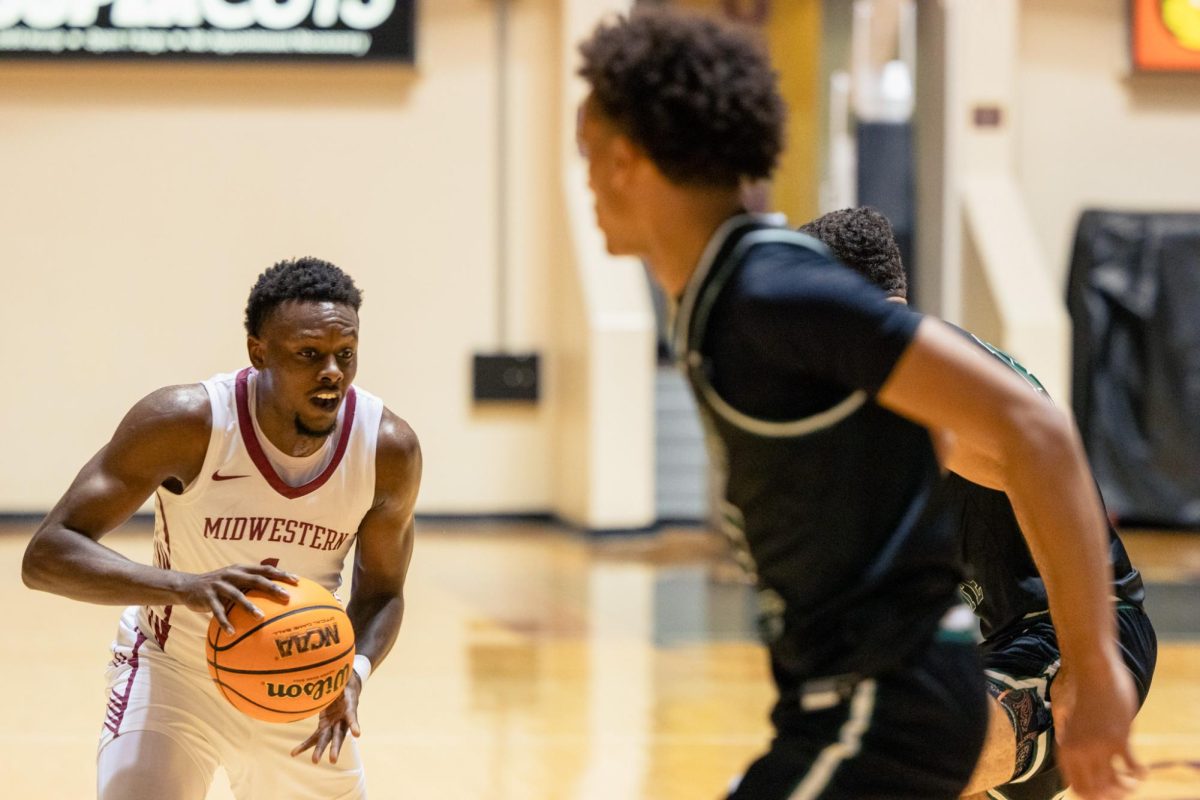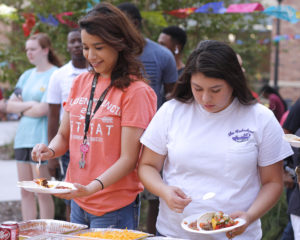
Students have been saturated in hispanic culture for Hispanic Heritage Month since Sept. 15. Vibrant dresses twirled at Viva MSU, sizzling fajitas coated the Jesse Rogers Promenade and laughter filled Comanche suits all to spark discussion towards hispanic culture, and students still have opportunities to experience hispanic culture for the month long celebration until Oct. 12.
Latino roots are rich, playing a meaningful part in the United States culture. As the components of the culture help shape America, the celebration allows the campus to experience Hispanic culture firsthand, as well as become more educated about diversity as it can eliminate any misconceptions about the culture. Especially with the population continuing to grow in the U.S., the blending of traditions, people and identity of the culture provide the meaningful influence of how it helps shape the nation. According to pewresearch.org, the U.S. Hispanic population now stands at 57 million, making Hispanics the nation’s second-fastest-growing racial or ethnic group after Asians. Today, Hispanics make up 18 percent of the U.S. population, up from 5 percent in 1970.
ENROLLMENT
There is a climbing rise of Hispanic students on campus as well. In 2012, 730 Hispanic students were enrolled, but in 2016, that number increased to 1,033. As the U.S. has never been a mono-language country, it makes sense to become Bilingual. Not only can it be helpful for a future career, it can help with communication between people of different cultures.
Mario Ramirez, interim director of student involvement said the campus has bigger population of Hispanic students, and “it’s highly important to be bilingual or have bilingual staff on campus” to be more aware and accommodating for students. Additionally, Gerardo Tenorio, business administration freshman said, it’s important to be bilingual because it can create more job opportunities.
Christina Lopez, pre-physical therapy freshman and Deferred Action for Childhood Arrivals recipient said “being bilingual is important as many people have told me that it will help you in life and in your career.”
According to Syreeta Greene, director of equity, inclusion and multicultural affairs, it’s unique that the United States doesn’t have the English language as the national language as they never started as a mono-language country.
“There are countries with their own dialect that have come along and are represented in the U.S. As like other countries bordered by others, it makes sense to understand the language of not only their own country but the one next to them as well,” Greene said. “It encourages folks to learn Spanish so they can communicate with each other as it’s important to become marketable which contributes to globalization.”
WORKFORCE
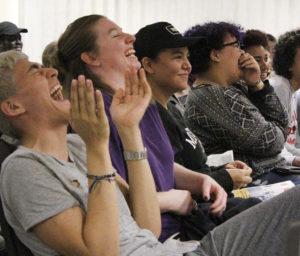
The Hispanic community has had to overcome some hard times this year. According to President Donald Trump, “It’s in the best interests of our country to begin an orderly transition and wind-down of DACA, one that provides minimum disruption. I am not going to just cut DACA off, but rather provide a window of opportunity for Congress to finally act. We will resolve the DACA issue with heart and compassion but through the lawful democratic process while at the same time ensuring that any immigration reform we adopt provides enduring benefits for the American citizens we were elected to serve.” Deferred Action for Childhood Arrivals is a program created in 2012 by the Obama administration allowing young people brought to this country illegally by their parents to get a temporary reprieve from deportation and to receive permission to work, study and obtain driver’s licenses. Immigrants under the DACA program will try to continue to persevere through this tough time but are willing to show why they deserve to stay ad become U.S. citizens.
“Being a DACA worker is a great opportunity Barack Obama opened up for many non-citizens of the United States,” Ruud Boijseauneau, DACA worker at Interstate Batteries in Dallas, said. “I feel I am part of this country for the two years that I am permitted to work in the U.S. Even though I was born in Mexico, I have lived longer in the U.S. I have graduated from college and contributed to society like every citizen of the U.S. by working to help the economy and pay taxes.”
DACA recipients “go through a lot of challenges” Lopez said, however, that doesn’t deter recipients and instead gives them a cause to fight for.
“Since I’m not from here, I’m not eligible for financial aid,” she said. “We may not be from here, but we came here for a reason. We deserve to become U.S. citizens.”
The Hispanic workforce has grown in the U.S. striving for a good life as well as providing a contribution to the economy.
According to The Bureau of Labor Statistics, the demographic shift with respect to ethnicity has also been increasing in recent years. Sparked by immigration and relatively high fertility rates, the number of Hispanics in the civilian U.S. workforce more than doubled, from 10.7 million to 25.4 million workers between 1990 and 2014. This 137-percent increase dwarfed the 13-percent increase in the number of non-Hispanic civilian workers by more than a factor of 10, nearly doubling the representation of Hispanics among all civilian workers during this time (from 8.5 percent to 16 percent).
FOOD
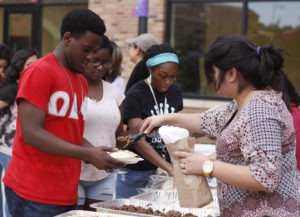
The unique culinary specialties play a meaningful part in the culture. It plays a role in everyday life and celebrations, and also connects people as it’s passed down from generations, and the Hispanic culture takes pride in these culinary dishes as it brings families together.
“It’s important to know the culture’s food as it’s easy to create conversation since everyone likes to eat,” Ramirez said. “You get to know more about the person, the culture and the traditions. For example, some foods are made from scratch, so one would like to know how that is made and its starts conversation which can allow the culture to carry on from generation to generation. My parents’ hometown is Pierdas Negras, Coahuila and that’s where nachos were first started. Of course, nachos have been brought over to the U.S. and is Americanized.”
According to Greene, food is always around every celebration because it contains its own identity, contains the identity of each culture and person.
“It’s part of the way they can pass down who they are and what’s important to them as those dishes are uniquely what makes who they are,” Greene said. “As passing down those family secrets and traditions can be meaningful meals that connect people to celebrate what’s important to them. Coming from Los Angeles, I am a fan of most Mexican foods especially street tacos or enchiladas.”
DANCING
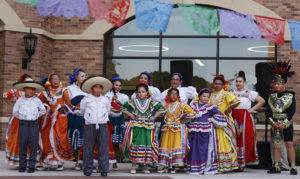
The crash of cymbals and ring of the accordion reflect the Folklorico and Mariachi music and tell the story of the heritage itself. Whether it’s the lively fast paced rhythm of the song, or the slow dance of a solo, music tells stories that gathers everyone in celebration to express the culture’s identity and way of life.
“The beats, different styles, the influence from the Incas, Aztecs and the Spanish all combined bring in a large variety emphasizes the culture and tradition,” Ramirez said. “Music to me is important as it celebrates the heritage as my favorite Mexican tradition is the Mariachi groups as to me it’s a big representation of what Mexico is about. It’s very socializing and brings the Hispanic families close together.”
According to Greene said movement is an important part of a culture. The instruments that are particular to the regions or areas from where they originate from bring in the cultural and traditional dances. For example, like mariachi, salsa, merengue and reggaeton are all very representative to those communities.
“It gives us an opportunity as citizens, a society to learn to engage and celebrate the various cultures that make up American culture,” Greene said. “Given that we do have a large Hispanic/Latinx community here in the United States, I think it is a great opportunity for folks to celebrate those who identify as being Hispanic to be able to celebrate who they are, their heritage, tradition, history and I think it is a great opportunity to exchange and share.”
According to Ramirez, everyone should come and experience it so they can understand the culture. There might be some misconceptions people may have about it or traditions they are not aware of, but part of the language or culture that some have not experienced can help people open their eyes as it can help them understand the importance of it and Maria Peña, Student Government Association president, said this is crucial for our student body to recognize.
“I would say that it is important for all students to be able to celebrate their heritage, beliefs and to express themselves freely as long as they are respectful toward one another,” Peña said. “It doesn’t necessarily have to just be Hispanic Heritage Month that we talk about when it comes to being inclusive on campus, but I think it is important to have an educational portion in events so we can provide a cultural awareness aspect that departments like student development provide as well.”





